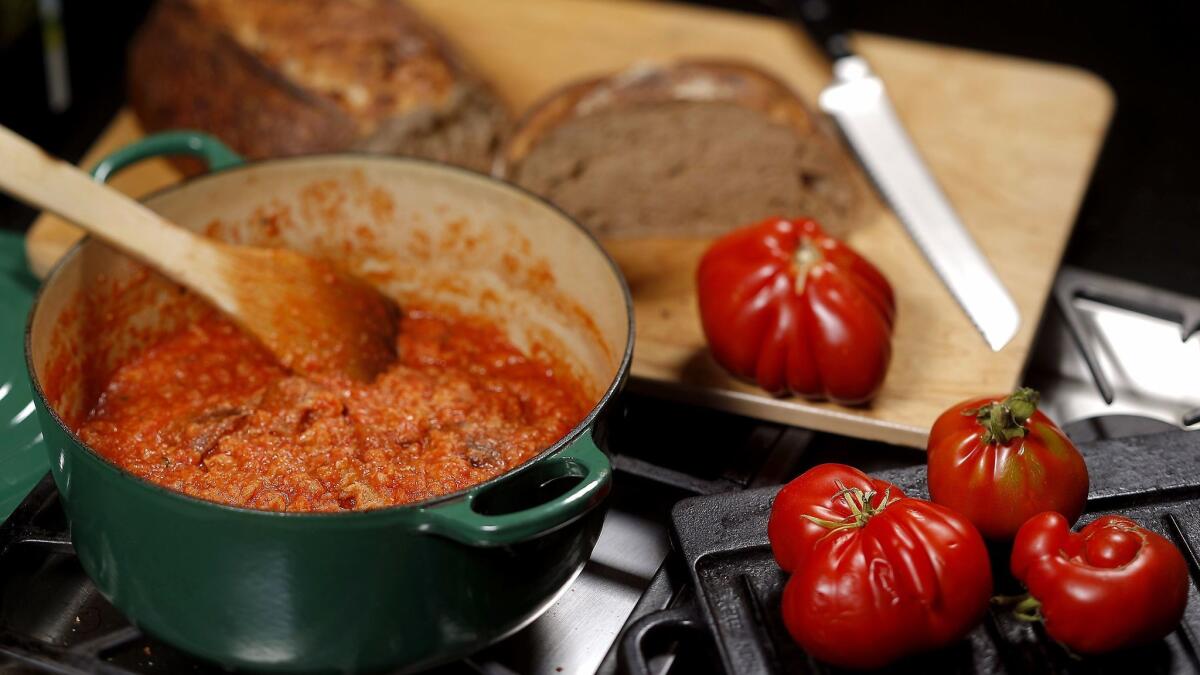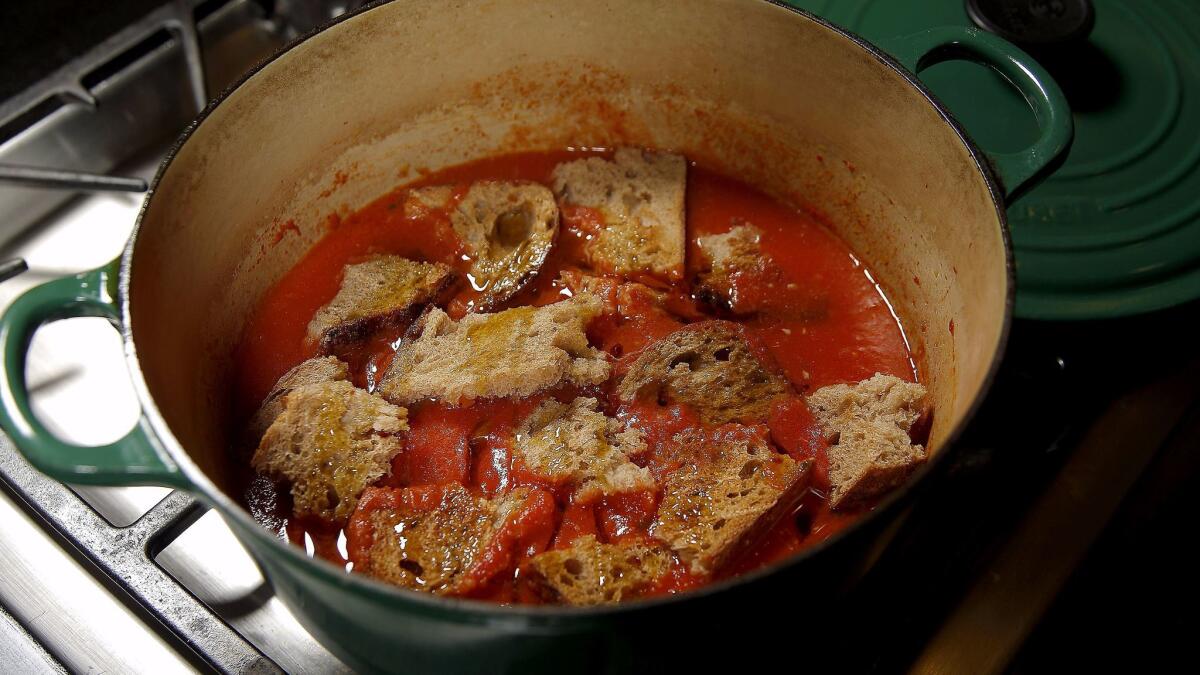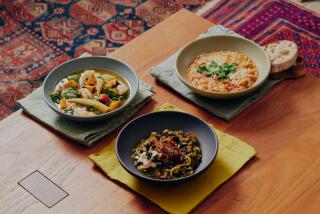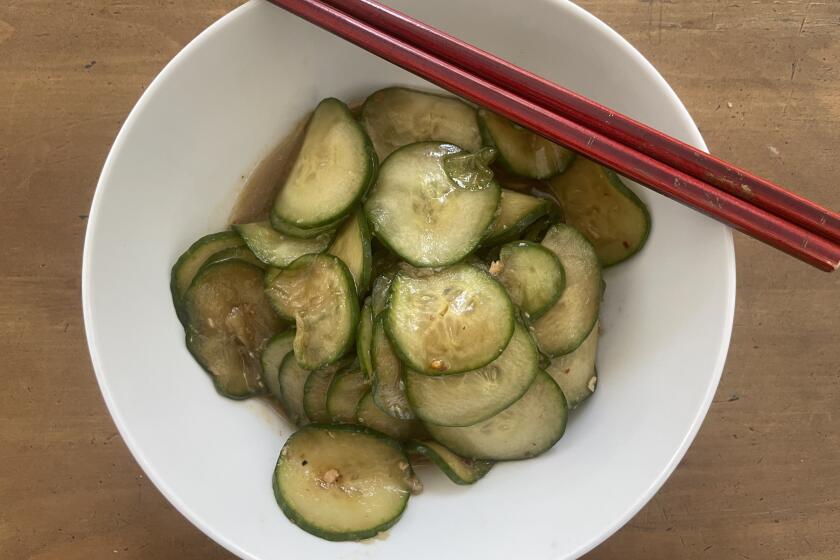Got a glut of tomatoes? Make the Tuscan dish pappa al pomodoro

The first time I had the Tuscan dish pappa al pomodoro, I was in my early 20s, considerably thinner and channeling my inner sophisticate at the famed restaurant Coco Lezzone in Florence, Italy. At the time — let us say 40 years ago — it was the place to be seen for those in the fashion industry. The customers were the definition of Milan chic; I was making an attempt in a Cacharel box pleat skirt and linen sweater.
So I sat alone, shoved in a corner near the entrance, when the mass of bread and tomatoes arrived, the waiter anointed the strange mixture with oil, and left me to have the oh-my-God reaction in private.
The first thing I noticed was the texture — it was the most elegant mush I’d ever held in a spoon. Rich with oil, it had body yet wasn’t heavy. Then there was the temperature. It seemed like the dish had been cooked and then served on the cooler side of warm, which allowed me to focus on the essential tomato flavor — deep and pungent, yet with the acid tempered by the soothing qualities of bread and oil. And the brick-red color of the humble bread soup was stunning.
You can easily see the roots of the dish in economical farmhouse cooking: You have some old bread, some ripe or canned tomatoes, a few bits of herb, maybe some salt, all thrown into a pot. The genius of pappa al pomodoro is that it’s a bowl of luxuriousness created from thrift.
That dish became one of my summer cooking rituals, at my home and professional kitchens.
Pappa al pomodoro was a way for us to mark the onset of deep summer at Angeli, when tomatoes were plentiful and ripe in the farmers markets. For two weeks over many of the nearly 30 years the restaurant was open, we ran it as a special — despite how hard it was to describe the texture or genre, as a “cold” soup that wasn’t gazpacho. I don’t know why it was always so hard to persuade folks to order it — but once they spooned up the dish, happiness always ensued.

If you’re a person who loves taking a bit of bread and scraping up the remaining sauce on your plate — what Italians call fare la scarpetta — this is the dish for you. To make it, just throw a few slices of toasted bread in a seasoned yet unreduced tomato sauce, stir the mixture a few times, cover and let it all absorb and mingle, then stir it again and serve, maybe topped with a sprinkle of Parmesan.
There are three primary ingredients: ideally, farmers market tomatoes, excellent olive oil and good rustic bread. If you have a bakery near you that uses freshly milled grain and a natural levain or starter, use that. (And don’t cut off those dark crusts; they add a different texture once softened.) As the dish was a way to use up stale bread, you can do that; if you have fresh bread, toast it before putting it in the pot, as the resulting texture will have a better mouthfeel than if you just tear up fresh untoasted bread.
In Tuscany, pappa al pomodoro can vary from a dish that’s mostly tomato with enough bread to thicken it, to a dish that’s mostly bread with just enough tomato to boost the flavor. (The word pappa means not “father” or “pope” but “pap,” as in what babies eat.) In Southern California at the height of summer, we have a glut of excellent, often heirloom tomatoes, so this version is uber tomato-ey.
To make approximately one quart of what will become your sauce, you’ll want about three pounds of ripe tomatoes. Look for tomatoes you love to eat out of hand with salt — you want big flavor. Some of my heirloom faves are Early Girls, Cherokee Purples, Brandywine and the Italian blocky ribbed varieties, but any good summer tomato with real flavor will do. You can use the canned variety, but I’d rather save the dish for when tomatoes are in season.
Good olive oil in sufficient quantity is essential to achieve the voluptuous mouthfeel that connotes luxury. And the sweetness of the tomatoes does the rest. I use a food mill to puree the sauce, as it removes skins and seeds and gives a nearly perfect puree. If you don’t have a food mill you can remove the skins by stirring the sauce with a whisk and then lifting them out, or just puree the whole thing with an immersion or regular blender.
When it’s done, you can serve the pappa hot, but I love it at room temperature or cold with a little sprinkle of Parmesan cheese. In the Italian context, this is served as a primo, or a small first course. But I had it recently for dinner cold from the refrigerator and I’m still so happy.
Kleiman ran Angeli Caffe for 27 years. She’s the longtime host of KCRW-FM’s “Good Food” and a member of the James Beard Foundation’s Who’s Who of Food & Beverage in America.
ALSO:
How to grill seafood bruschetta like an Italian
Making pasta all’Amatriciana, the classic Italian pasta dish
Pasta PSA: Please don’t buy terrible supermarket fresh pasta. Here’s why
More to Read
Eat your way across L.A.
Get our weekly Tasting Notes newsletter for reviews, news and more.
You may occasionally receive promotional content from the Los Angeles Times.







